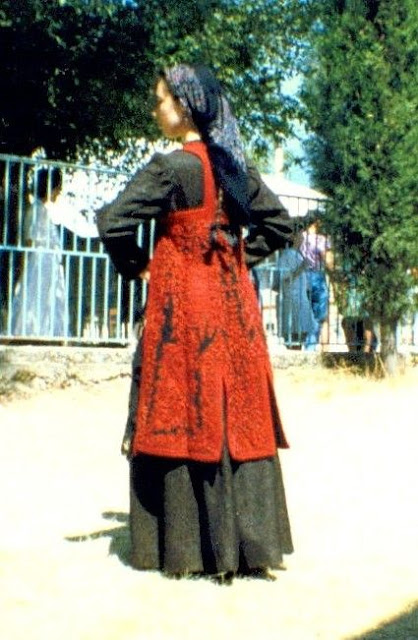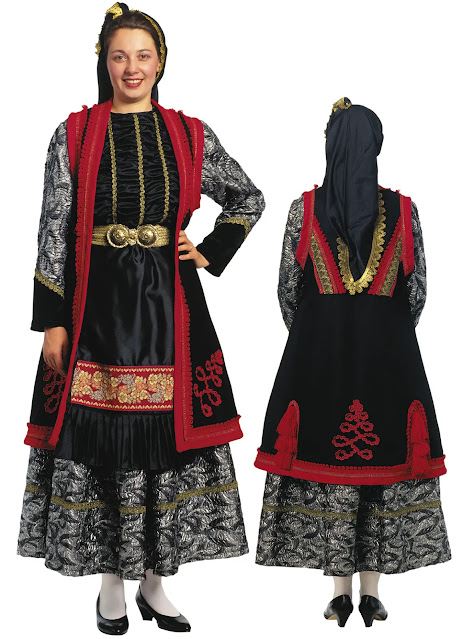Hello all,
Today I would like to continue my coverage of the Folk Costumes of Epirus, or Ipiros, Ήπειρος, by talking about the municipalities in the north of Ioanniana: Zagori, Ζαγόρι, Konitsa Κόνιτσα, and Zitsa Ζίτσα.
Epirus today is divided into 4 regional units, περιφερειακές ενότητες, each of which is divided into municipalities. Epirus is found in northwestern Greece, along the Albanian border and the Ionian Sea.
https://en.wikipedia.org/wiki/Epirus_(region)
The Regional Unit of Ioannina, Ιωάννινα or Γιάννενα lies in the northeast part of Epirus. It is divided into 8 municipalities.
s://en.wikipedia.org/wiki/Ioannina_(regional_unit)http
Zagori is labelled no 5 on this map above. Pogoni, which I have covered in a previous article, is no 8, Konitsa is 6, and Zitsa is 4.
https://en.wikipedia.org/wiki/Zagori
Zagori Greece, is not contiguous with Zagori Albania, and neither abuts the current border. The name Zagori is neither Greek nor Albanian, but Slavic, meaning "beyond the mountains". [There are also regions with this name in both Bulgaria and Croatia.] There are some similarities in culture, and the dance Zagorisios or Valle Zagoriste is done in both regions and also in other nearby areas, such as Pogoni.
The population of Zagori is mostly Greek, with Vlachs in the east, and some admixture of Arvanite Albanians.
https://en.wikipedia.org/wiki/Zagori
The costume of this region has some elements in common with that of Ioannina.
The costume in recent times was of the urban style, first leaning Ottoman, and then Western. The old costume consisted of a linen or cotton chemise, pokamiso, with a long kaftan like garment, foustani over it. This was open on the breast, and had long sleeves which reached past the hands. It was slit up the forearms to varying degrees. The foustani was fastened at the waist, but the lower parts were open. The pokamiso might have ornament that was visible at the front opening and cuffs. The foustani was generally made in rich materials, stripes or damask, etc.
Sometimes the front opening was covered by a dickey of contrasting color.
The outfit was completed with an apron, usually in black with floral embroidery, a belt, and an outer garment called flokata, which is ornamented with red cording on black wool. This somewhat resembles the pirpiri worn in places like Argyrokastro and Ioaninna, but is much less full, with different ornament.
In more recent times, the pokamiso has become a foundation garment and the foustani has become more western, forming a sort of dress. This garment is closed in front up to the neck, and is closed at the wrist, sometimes with cuffs. It has set in cap sleeves in the 19th/20th cent style, sometimes puffed at the shoulder, instead of the traditional sleeves which were set in at right angles, in what today is called a "drop shoulder". This garment is in rich cloth, often in dark shades. The details of the neck opening and hem ornamentation vary.
The belt is often of metal, with large Balkan style buckles, and the apron is usually black with floral embroidery.
The flokata is made of heavy black wool, the finest ones were traditionally made from cloth imported from Bitola. It does not close in front, in fact, it is hardly visible from the front at all. The ornament is always in red, although the details vary widely. The Zagori flokata is heavily ornamented all over.
The head covering seen today is a black kerchief, tied behind the head in a couple different styles.
A few other images.
In the eastern part of Zagori the Vlach population wears a similar costume. However the men wear a sort of knee length tunic over a double breasted vest, and the women tend to wear aprons and dresses ornamented with ribbon, and the flokata is much less ornamented, sometimes only having a red edging.

The next step was to urbanize the costume by replacing the linen chemise with a dress in colored fabric, much like that worn in Zagori. This had a longer hem. The tsarouchia were replaced by urban shoes. The fez was replaced by a kerchief. The cuffs of the dulamas were sometimes no longer open along the seam. The flokata received two rows of gold buttons along the opening.
The most recent stage was simplification of the entire outfit. The dulamas was lost, the hem of the dress shortened, the apron was made simpler, with floral embroidery. There appeared ornament on the front opening that resembles a bodice. Perhaps it is a bodice, it is difficult to tell from the fully dressed images. The image above also seems to show a bodice of a different color.
Here are images of a dance performance by a group dressed in the contemporary costumes of the village of Rodotopi Ροδοτόπι.

.png)

.png)

.png)
.png)

.jpg)











































.png)




.jpg)



































That mass of Zagori flokata on the stairs is splendid!
ReplyDelete